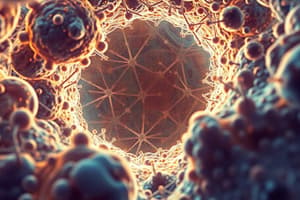Podcast
Questions and Answers
Which of the following is the primary function of a microscope?
Which of the following is the primary function of a microscope?
- To manipulate objects at a microscopic scale.
- To observe objects too small to be seen with the naked eye. (correct)
- To measure the mass of small objects.
- To analyze the chemical composition of specimens.
What year was the first compound microscope invented?
What year was the first compound microscope invented?
- 1655
- 1700
- 1590 (correct)
- 1550
Who is credited with first observing cells using a microscope?
Who is credited with first observing cells using a microscope?
- Robert Hooke (correct)
- Robert Brown
- Zacharias Janssen
- Antoine van Leeuwenhoek
Antoine van Leeuwenhoek is best known for what contribution to microscopy?
Antoine van Leeuwenhoek is best known for what contribution to microscopy?
Which type of microscope is most suitable for observing very small objects such as viruses and DNA?
Which type of microscope is most suitable for observing very small objects such as viruses and DNA?
What is the function of the scanning electron microscope?
What is the function of the scanning electron microscope?
Which type of microscope uses multiple lenses and visible light to magnify small objects?
Which type of microscope uses multiple lenses and visible light to magnify small objects?
What is a key difference between a simple and a compound microscope?
What is a key difference between a simple and a compound microscope?
What is the main purpose of the mechanical parts of a compound microscope?
What is the main purpose of the mechanical parts of a compound microscope?
What is the function of the 'arm' (or neck) of a microscope?
What is the function of the 'arm' (or neck) of a microscope?
Which microscope component secures the specimen to the stage for observation?
Which microscope component secures the specimen to the stage for observation?
Where are the objective lenses typically attached on a microscope?
Where are the objective lenses typically attached on a microscope?
What is the purpose of the dust shield on a microscope?
What is the purpose of the dust shield on a microscope?
What is the function of the coarse adjustment knob on a microscope?
What is the function of the coarse adjustment knob on a microscope?
Which part of the microscope is used for precise focusing after the coarse adjustment has been made?
Which part of the microscope is used for precise focusing after the coarse adjustment has been made?
What is the role of the condenser adjustment knob in microscopy?
What is the role of the condenser adjustment knob in microscopy?
What does the iris diaphragm lever control in a microscope?
What does the iris diaphragm lever control in a microscope?
Where is the mirror located within the microscope setup, and what is its function?
Where is the mirror located within the microscope setup, and what is its function?
What is the key difference between the ocular lens and the objective lens in a microscope?
What is the key difference between the ocular lens and the objective lens in a microscope?
Why does the amount of the cell that can be viewed decrease as magnification increases?
Why does the amount of the cell that can be viewed decrease as magnification increases?
Which of the following is a recommended practice for caring for a microscope?
Which of the following is a recommended practice for caring for a microscope?
How should a microscope be properly carried?
How should a microscope be properly carried?
What is the purpose of using cover slips and microscope slides?
What is the purpose of using cover slips and microscope slides?
In preparing a wet mount slide, why is it important to slowly lower the coverslip?
In preparing a wet mount slide, why is it important to slowly lower the coverslip?
What is the primary reason for using stains in microscopy?
What is the primary reason for using stains in microscopy?
For what type of cell is methylene blue typically used as a stain?
For what type of cell is methylene blue typically used as a stain?
Which of the following is an example of a microscopic adaptation?
Which of the following is an example of a microscopic adaptation?
What is the term for the way living organisms cope with environmental stresses and pressures?
What is the term for the way living organisms cope with environmental stresses and pressures?
Which type of adaptation involves a body part or coloring that aids in survival?
Which type of adaptation involves a body part or coloring that aids in survival?
What is the purpose of prepared steps in laboratory activity?
What is the purpose of prepared steps in laboratory activity?
What is setae?
What is setae?
What is flagella?
What is flagella?
For what type of cell is iodine solution used?
For what type of cell is iodine solution used?
What is Trichomes?
What is Trichomes?
What are the three types of microscopes?
What are the three types of microscopes?
What can organisms be adapted to in their environment?
What can organisms be adapted to in their environment?
What feature is shared between Scanning Electron Microscopes and Transmission Electron Microscopes?
What feature is shared between Scanning Electron Microscopes and Transmission Electron Microscopes?
Which magnification would be achieved via a High Power Objective?
Which magnification would be achieved via a High Power Objective?
If the OIO objective gives the highest magnification, which of the following would it achieve?
If the OIO objective gives the highest magnification, which of the following would it achieve?
Flashcards
Microscope
Microscope
An instrument used to see objects that are too small for the naked eye.
1590
1590
First compound microscope by Zacharias Janssen.
1665
1665
Robert Hooke used a compound microscope to observe pores in cork; he called it 'cells'.
Antoine van Leeuwenhoek
Antoine van Leeuwenhoek
Signup and view all the flashcards
Compound Light Microscope
Compound Light Microscope
Signup and view all the flashcards
Electron Microscope
Electron Microscope
Signup and view all the flashcards
Transmission Electron
Transmission Electron
Signup and view all the flashcards
Scanning Electron
Scanning Electron
Signup and view all the flashcards
Compound Microscope
Compound Microscope
Signup and view all the flashcards
Simple Microscope
Simple Microscope
Signup and view all the flashcards
Mechanical Parts
Mechanical Parts
Signup and view all the flashcards
Base
Base
Signup and view all the flashcards
Pillar
Pillar
Signup and view all the flashcards
Inclination Joint
Inclination Joint
Signup and view all the flashcards
Arm/neck
Arm/neck
Signup and view all the flashcards
Stage
Stage
Signup and view all the flashcards
Stage clips
Stage clips
Signup and view all the flashcards
Body tube
Body tube
Signup and view all the flashcards
Draw tube
Draw tube
Signup and view all the flashcards
Rotating nose piece
Rotating nose piece
Signup and view all the flashcards
Dust shield
Dust shield
Signup and view all the flashcards
Coarse Adjustment Knob
Coarse Adjustment Knob
Signup and view all the flashcards
Fine Adjustment Knob
Fine Adjustment Knob
Signup and view all the flashcards
Condenser adjustment knob
Condenser adjustment knob
Signup and view all the flashcards
Iris diaphragm lever
Iris diaphragm lever
Signup and view all the flashcards
Mirror
Mirror
Signup and view all the flashcards
Electric lamp
Electric lamp
Signup and view all the flashcards
Ocular/Eyepiece
Ocular/Eyepiece
Signup and view all the flashcards
Objectives
Objectives
Signup and view all the flashcards
Scanning Lens
Scanning Lens
Signup and view all the flashcards
LPO
LPO
Signup and view all the flashcards
HPO
HPO
Signup and view all the flashcards
OIO
OIO
Signup and view all the flashcards
Adaptation
Adaptation
Signup and view all the flashcards
Microscopic Adaptations
Microscopic Adaptations
Signup and view all the flashcards
Trichomes
Trichomes
Signup and view all the flashcards
Setae
Setae
Signup and view all the flashcards
Flagella
Flagella
Signup and view all the flashcards
Stigma
Stigma
Signup and view all the flashcards
Spores
Spores
Signup and view all the flashcards
Study Notes
- A microscope is an instrument used to see objects that are too small for the naked eye
History of Microscopes
- 1590: The first compound microscope was invented by Zacharias Janssen.
- 1655: Robert Hooke used a compound microscope to observe pores in cork, naming them "cells".
- Antoine van Leeuwenhoek was the first to observe single-celled organisms in pond water.
Types of Microscopes
-
Compound Light Microscope:
- It is the first type of microscope
- It is the most widely used microscope
- Light passes through lenses
- Capable of magnifying up to 2,000x
-
Electron Microscope:
- Uses beams of electrons
- It is needed to observe very small objects, such as viruses, DNA, and parts of cells
-
Transmission Electron Microscope:
- Uses transmitted electrons to create an image
- Used to study the internal structures of a cell
-
Scanning Electron Microscope:
- Creates an image by detecting reflected or knocked-off electrons
- Used to study the detailed surface of a specimen
-
Compound Light Microscope uses multiple lenses and visible light to magnify small objects
-
Electron Microscope uses a beam of electrons to magnify specimens
-
Transmission Electron Microscope passes electrons through a thin specimen to study internal structures
-
Scanning Electron Microscope scans a sample's surface to produce detailed 3D images
-
Simple Light Microscopes use a single lens
-
Compound Light Microscopes use a set of lenses or a lens system
Compound Microscope Parts
-
The Mechanical Parts:
- Base: The bottommost portion that supports the microscope
- Pillar: Part above the base that supports the other parts
- Inclination Joint: Allows tilting of the microscope for user convenience
- Arm/Neck: The curved/slanted part held while carrying the microscope
- Stage: The platform where objects are examined
- Stage Clips: Secures the specimen to the stage
- Body Tube: Attached to the arm and supports the lenses
- Draw Tube: Cylindrical structure on top of the body tube that holds the ocular lenses
- Revolving/Rotating Nose Piece: The rotating disc where objectives are attached
- Dust Shield: Sits atop the nose piece, keeping dust from settling on the objectives
- Coarse Adjustment Knob: Geared to the body tube, elevating or lowering when rotated to bring the object into approximate focus
- Fine Adjustment Knob: A smaller knob for delicate focusing, bringing the object into perfect focus
- Condenser Adjustment Knob: Elevates and lowers the condenser to regulate light intensity
- Iris Diaphragm Lever: Controls the diaphragm, moving horizontally to open/close it
-
Illuminating Parts:
- Mirror: Located beneath the stage with concave and plane surfaces, gathers and directs light to illuminate the object
- Electric Lamp: A built-in illuminator beneath the stage, used if sunlight is unavailable or not preferred
-
Magnifying Parts:
- Ocular/Eyepiece: Lens on top of the body tube, further magnifying the image produced by objective lenses, it usually ranges from magnifications of 5x to 20%.
- Objectives: Metal cylinders attached below the nosepiece, containing specially ground and polished lenses
- Scanning Lens: Provides the lowest magnification, usually 4x
- LPO (Low Power Objective): Higher than the scanning lens, typically 10x
- HPO (High Power Objective): Generally provides a higher magnification, usually 40x
- OIO (Oil Immersion Objective): Gives the highest magnification, usually 100x
-
As magnification increases, detail increases but less of the cell is seen.
Caring for the Microscope
- Do not let any liquids come in contact with the microscope
- Always store the microscope inside a box after use
- Return the objective lens onto low power after use
- Carry the microscope by the arm
- Use a soft, clean tissue to wipe the lenses
Cover Slips and Microscope Slides
Preparing a Slide as a Wet Mount
- Add a drop of water to a slide
- Place the specimen in the water
- Position the edge of a coverslip on the slide so that it touches the water's edge
- Slowly lower the coverslip to prevent forming and trapping air bubbles
Use of Stains
- Some parts of a plant cell can be clearly seen when the cell is mounted in water, examples include Stomata and Guard Cells
- Other cell structures not so obvious are often shown more clearly by the addition of dyes called stains
- Iodine solution is used to stain plant cells
- Methylene blue is used to stain animal cells
Microscopic Adaptations
- Adaptation is how living organisms cope with environmental stresses and pressures
- Organisms adapted to their environment can get air, water, food, and nutrients
- They can cope with physical conditions (temperature, light, and heat) and defend themselves against natural enemies
- Reproduction and responding to environmental changes are also key for survival
Types of Adaptations
- Physiological Adaptations jobs of body parts controlling the life processes to aid survival, example snake making venom
- Structural Adaptations body part/coloring that aids survival, example mimicry
- Behavioral Adaptations actions that aid survival, example hibernation/migration
- Microscopic Adaptations structure not seen with naked eye but impacting survival, example trichomes
- Other examples include setae, flagella, stigma, and spores
Studying That Suits You
Use AI to generate personalized quizzes and flashcards to suit your learning preferences.




